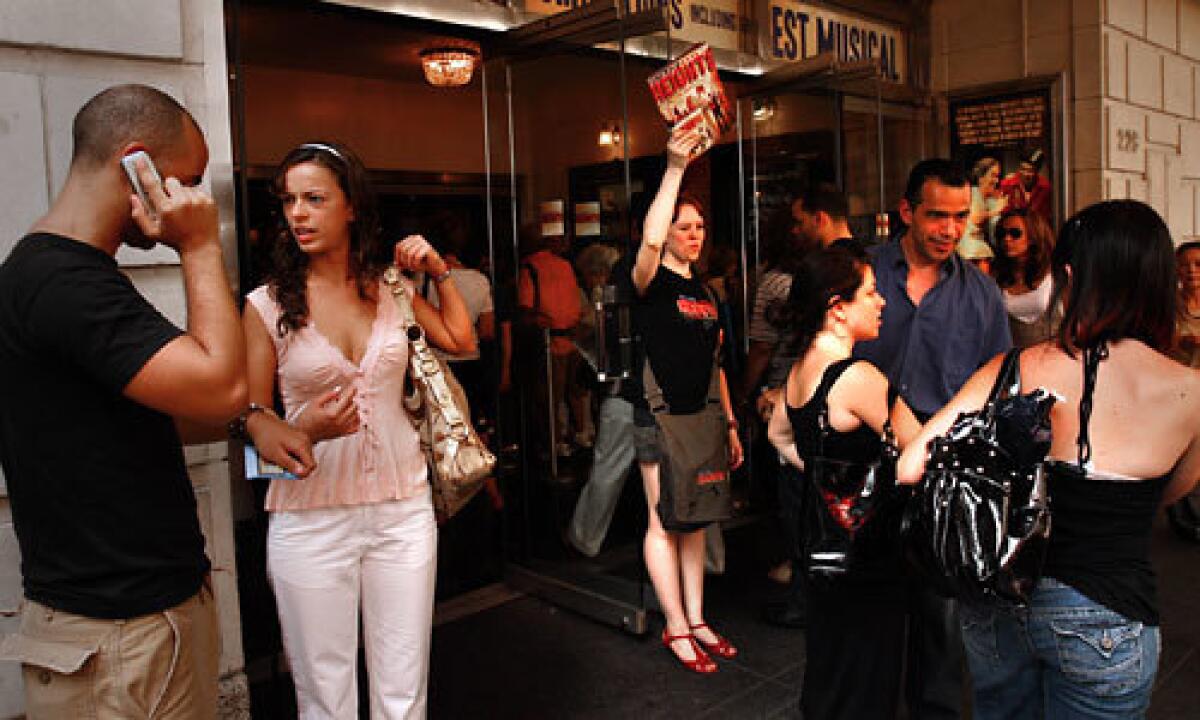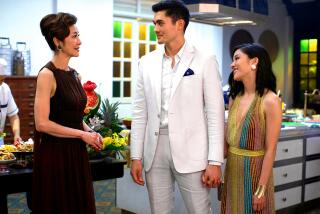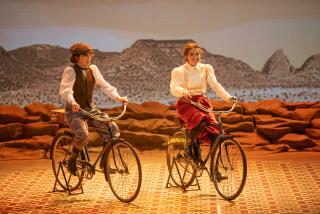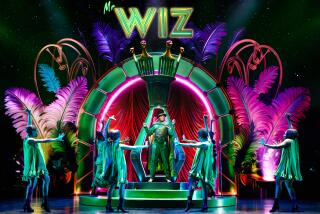Tony-contending musicals bring new audiences to Broadway

THERE ARE telltale moments when Lin-Manuel Miranda, the star and creator of “In the Heights,” knows who’s in the audience to see his new musical about Latinos in Upper Manhattan: Whenever he mentions the Dominican Republic or Puerto Rico in a rap song, or watches cast members unfurl the Mexican flag, ecstatic cheers ring out.
Similar moments occur for Stew, who wrote and performs in “Passing Strange,” the new musical about an African American kid from Los Angeles and his quest for artistic identity in Amsterdam and Berlin. At key points, large blocks of the audience -- often blacks and young people -- rise to their feet singing, as though they are in church or at a rock concert.
Has Broadway finally found the younger, more ethnically diverse audience it’s been seeking for years? Both shows are the top contenders for this year’s best musical, to be announced at the Tony Awards on Sunday, and their creators offered similar explanations for the new faces they’re seeing: “I wanted to put on a show that looked like the world I grew up in,” said Miranda. Meanwhile, “Passing Strange,” Stew said, draws new patrons “because we encourage people to participate. It’s like we’ve given them their own voice in the theater.”
In a season when blockbuster musicals like “Young Frankenstein” and “The Little Mermaid” were dismissed by critics, the remarkable success of “In the Heights” (13 Tony nominations) and “Passing Strange” (seven nominations) suggests the quest for new audiences is gaining momentum. Although other musicals and plays this season catered to older, more traditional crowds, Miranda and Stew’s shows are carrying on a creative -- and financial -- quest for new audiences that began 12 years ago with musicals like “Rent” and continued with “The Color Purple,” “Wicked,” “Legally Blonde,” “Spring Awakening” and “Avenue Q,” along with plays like “A Raisin in the Sun” and this year’s all-black “Cat on a Hot Tin Roof.”
“Broadway at its best should reflect every aspect of America,” said Kevin McCollum, who produced “In the Heights” as well as “Rent” and “Avenue Q.” “So it’s crucial that we get new people into the seats. Ideally, there should be something for everybody to see.”
The stakes are high: Many believe the Great White Way will lose its cultural relevance unless it taps into a new and younger customer base to replace its aging clientele. But that’s easier said than done. While producers have sponsored discount pricing programs, $120 tickets remain the norm for most shows. Promoters also face a cultural obstacle because they’re trying to reach a generation that did not grow up going to the theater.
So far, “In the Heights” has built an audience with radio, TV and newspaper ads, video marketing and word of mouth; its gross sales filled 81.9% of the house last week, according to industry statistics. But “Passing Strange” has struggled, drawing only 50.8%, despite a TV and radio campaign and saturation ads on city buses. It’s the first Broadway musical to sell its cast recording online before the CD goes on sale.
Nonwhite influx
Broadway’s biggest boosters say they have made impressive strides in attracting new audiences. A study by the League of American Theatres and Producers found that 26% of all tickets sold in the 2006-07 season were purchased by non-Caucasians, a record number and a 13% jump from the previous year. Much of the increased business was sparked by “The Color Purple,” whose cast included “American Idol” winner Fantasia; “110 in the Shade,” which featured Audra McDonald; and other shows, said Charlotte St. Martin, the league’s executive director. As for younger audiences, the percentage of patrons under 24 rose to 22%, compared with 20.4% the previous year.
“We’ve never been so diverse in the number of shows out there for kids, preteens and people in their 20s,” said St. Martin. “None of this is happening by accident. People made it clear they want these kinds of choices.”
And producers, of course, want to make money. The growth in the youngest slice of the Broadway audience is largely attributable to Disney’s box-office success with shows like “The Lion King” and “Mary Poppins.” But staging new, less familiar shows for slightly older audiences can be creatively and financially risky.
Miranda, a 28-year-old theater buff, began writing his musical as a student at Wesleyan. He was keenly aware that the last hit musical to portray Latinos on Broadway, “West Side Story,” was dark and violent. His upbeat, family-friendly show, which played off-Broadway before moving to the Rialto, offers a radically different view of the Latino community, focusing on a Washington Heights neighborhood facing change and gentrification. Fueled by pulsing Latin and hip-hop rhythms, it’s a feel-good hymn to family, roots and ethnic pride, filled with ordinary people who are grappling with issues of home and identity. Several critics have compared the visually stunning show to “Fiddler on the Roof.”
“I had to come see it,” said Maria Gonsalves, a young woman who has lived most of her life in Washington Heights and was waiting in line at the Richard Rodgers Theatre. “When someone puts on a show about your world, with people like you, you’ll go see it.”
‘Strange’ journey
If Miranda had visions of Broadway success, Stew (real name, Mark Stewart) seems shocked he’s performing every night on West 44th Street. The 46-year-old singer created a show with his partner, Heidi Rodewald, that blends high-voltage rock with performance art and cabaret. “Passing Strange,” developed at Sundance Theatre Lab in Utah, played at Berkeley Repertory and New York’s Public Theater before moving uptown.
Variety called it “boldly atypical Broadway fare that pulses with a new vitality.” The Wall Street Journal dubbed it “the freshest musical in town . . . engaging and unpretentious.” “Passing Strange” snared honors for best new musical from the New York Drama Critics’ Circle, the Drama Desk Awards and the Obie Awards. But the irony, mused director Annie Dorsen, is that it’s hard to describe the unorthodox production in one or two punchy sentences. With its focus on race, sex and artistic identity, and its hard-rock jams, it’s a miracle the show got to Broadway, she added.
“Although our producers might hate me for saying it, they feel there are some good reasons to have taken a risk on ‘Passing Strange,’ even if it ends up losing money,” Dorsen said. “Everyone believes the show can be profitable. But there was a little missionary zeal involved. They were bringing a piece to Broadway that could have some real cultural impact.”
As she walked into the Belasco Theatre, Elizabeth Antwi, 24, seemed to prove them right. An African American student of psychology at Columbia University, she was offered discount seats to one of three shows. “Passing Strange” was an easy choice.
“It seems original and kind of different. Plus, it has a large African American cast, and they say the music is good too. That will get me to the theater any time.”
More to Read
The biggest entertainment stories
Get our big stories about Hollywood, film, television, music, arts, culture and more right in your inbox as soon as they publish.
You may occasionally receive promotional content from the Los Angeles Times.






